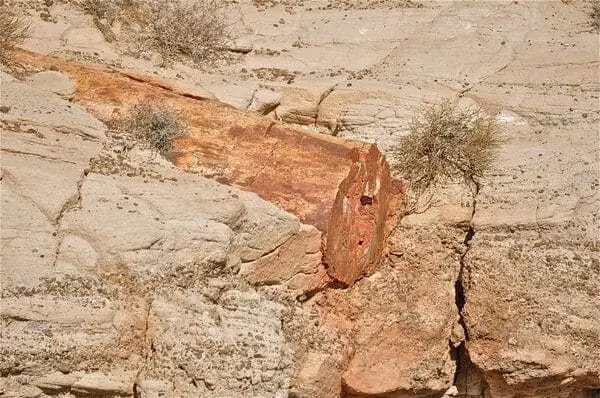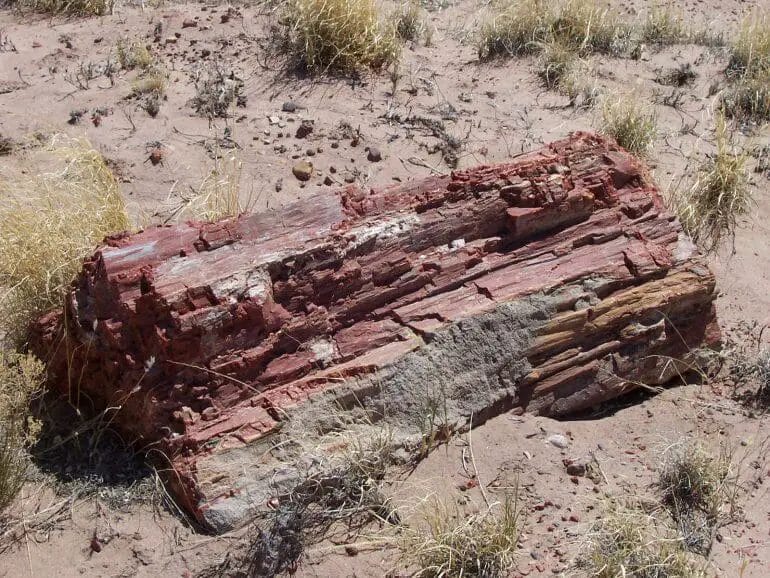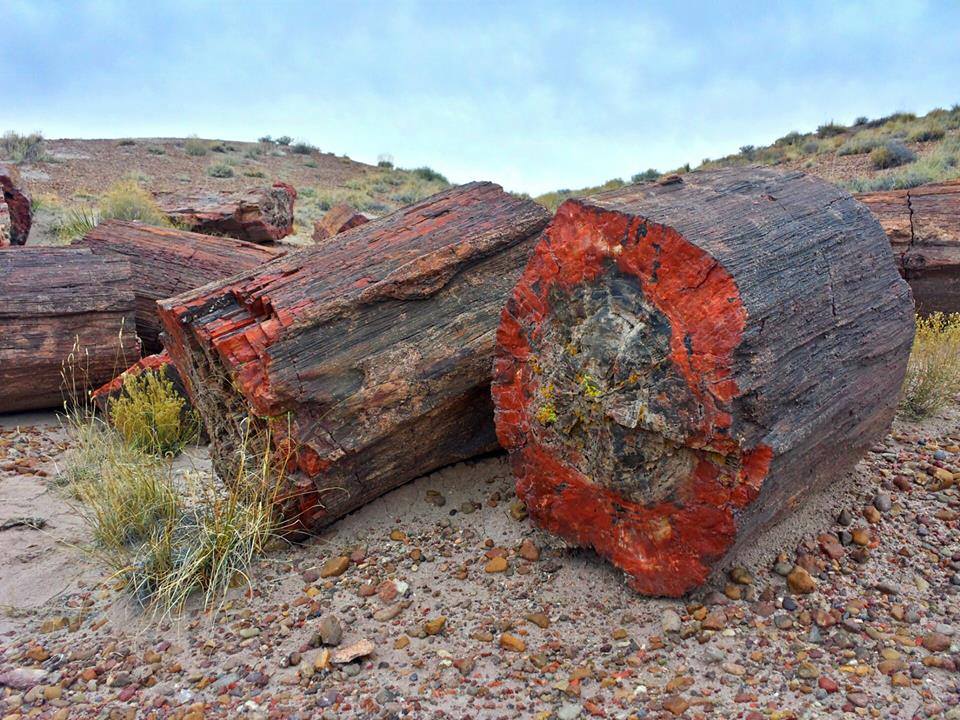Curious about the fascinating process of petrification? Wondering how long it takes for wood to transform into stone? Petrification occurs when organic material, like wood, is gradually replaced by minerals, resulting in a durable stone-like substance. The duration of this process can vary based on several factors, such as the type of wood and environmental conditions. Generally, it can take thousands or even millions of years for wood to fully petrify. Let’s delve deeper into this captivating phenomenon and uncover the secrets of petrified wood!

Factors Influencing the Petrification Timeframe
When it comes to the natural process of petrification, various factors come into play, influencing the timeframe within which organic material transforms into stone. Petrification, also known as mineralization, is a geological process that replaces the original organic matter with minerals, resulting in the preservation of the material in a solid, stone-like state.

Understanding the different factors that affect the petrification timeframe can help us comprehend the variations observed in fossilization processes across different specimens and locations. Let’s explore some of the key factors influencing the petrification timeframe:
1. Type of Organic Material
The type of organic material plays a significant role in determining the petrification timeframe. Soft tissues, such as muscles and skin, generally have a higher likelihood of decay before the mineralization process can occur. On the other hand, hard tissues like bones and teeth have a higher chance of being preserved and mineralized, resulting in a faster petrification process.
2. Environmental Conditions
The environmental conditions in which the organic material is deposited also impact the petrification timeframe. Factors such as temperature, moisture levels, and the presence of minerals in the surrounding sediment can either accelerate or hinder the mineralization process. For example, if the conditions are ideal with a high mineral content and limited exposure to oxygen, the petrification process can occur relatively quickly.
3. Degree of Burial
The degree of burial of the organic material can significantly influence the petrification timeframe. Deeper burial provides a protective environment that shields the material from exposure to oxygen, bacteria, and other factors that promote decay. Increased burial depth can expedite the mineralization process by creating the necessary conditions for the infiltration of minerals into the organic material.
4. Mineral Availability
The availability of minerals within the surrounding sediment is crucial for the petrification process. Certain minerals, such as silica, calcite, and pyrite, have the potential to replace the organic material and preserve its structure. The presence of these minerals in the environment can enhance the rate of petrification, while their absence may hinder or delay the process.
5. Geological Activity
Geological activity in the form of tectonic movements, volcanic eruptions, or sedimentary deposition can impact the petrification timeframe. These geological processes can disrupt or accelerate the burial and preservation of organic material, influencing the overall rate of petrification.
6. Time
Petrification is a time-consuming process that occurs over thousands or even millions of years. The longer the organic material remains within the petrification environment, the greater the chance of complete mineral replacement. Time is an essential factor in the petrification timeframe, allowing for the gradual transformation of organic material into stone.
In summary, the petrification timeframe is influenced by various factors, including the type of organic material, environmental conditions, degree of burial, mineral availability, geological activity, and the element of time. Each of these factors plays a significant role in shaping the petrification process and determining the duration it takes for organic material to undergo mineralization and transform into stone.

Myth or Reality: Unraveling the Mystery of the Fastest Petrification Record
Petrification, the process by which organic material is transformed into stone, has long fascinated scientists and captured the imagination of the public. The idea of an organism turning into a solid object over time seems almost otherworldly. However, there is a longstanding debate in the scientific community surrounding the fastest petrification record.
While many believe that petrification is a slow and gradual process that takes thousands, if not millions of years, there are claims of exceptionally fast petrification that defy conventional wisdom. In this article, we aim to explore the myth or reality behind the fastest petrification record and shed light on the scientific evidence surrounding this phenomenon.
The Origins of Petrification
Petrification occurs when minerals replace the organic material of a once-living organism, preserving its structure and turning it into stone. This process requires specific conditions, typically involving the presence of water and mineral-rich sediment. Over time, as the minerals infiltrate the organic material, they gradually replace its original composition, resulting in a fossilized form.
Traditionally, petrification has been associated with slow and gradual processes. For example, the petrification of a tree or animal bone in a sedimentary environment can take millions of years. This slow transformation allows for the preservation of intricate details, providing valuable insights into the Earth’s history and the organisms that once thrived.
The Controversial Claims: Rapid Petrification
Despite the prevailing belief in the gradual nature of petrification, there have been intriguing claims of rapid petrification that challenge this notion. Some researchers and enthusiasts argue that certain circumstances can accelerate the process, resulting in rapid fossilization.
One notable example is the case of the “Moa’s Ark,” a collection of petrified trees in New Zealand. According to local legend, a massive flood swept through the region, burying the trees in sediment and causing them to petrify within a short period. While this claim has not been scientifically proven, it raises questions about the potential for rapid petrification under specific conditions.
Examining the Evidence
The debate surrounding rapid petrification hinges on the interpretation of available evidence. Proponents of rapid petrification argue that certain factors, such as the presence of high mineral content in the surrounding environment or rapid burial, can expedite the process.
Opponents, on the other hand, emphasize the importance of time and gradual mineral infiltration in the formation of fossils. They contend that the structure and complexity of fossilized organisms can only be preserved through a slow and meticulous process.
Researchers have conducted experiments to investigate the plausibility of rapid petrification. These experiments involve subjecting organic material to high-pressure environments and mineral-rich solutions to simulate the conditions thought to facilitate rapid fossilization. While some promising results have been obtained, further research is needed to verify the validity of these findings.
The Verdict: Myth or Reality?
In summary, the mystery surrounding the fastest petrification record remains unresolved. While there are claims and anecdotal evidence suggesting the possibility of rapid petrification, the scientific community has yet to reach a consensus on the matter.
It is essential to approach these claims with caution and maintain a rigorous scientific approach when evaluating petrification records. Additional research and experimentation are necessary to uncover the underlying mechanisms and conditions that may contribute to rapid fossilization.
Until then, the debate between myth and reality continues, adding to the intrigue and allure of petrification as a fascinating natural phenomenon.

Geological Wonders: Famous Petrified Wood Sites Around the World
Petrified wood is a fascinating natural phenomenon that occurs when trees or woody plants undergo a process of mineralization, transforming them into stone over thousands or millions of years. This unique transformation creates mesmerizing fossilized wood that showcases the intricate details of the original tree. Throughout the world, there are several renowned sites where you can witness the beauty and wonder of petrified wood. Let’s explore some of these famous petrified wood sites:
Petrified Forest National Park, Arizona, United States
Located in Arizona, Petrified Forest National Park is home to one of the largest concentrations of petrified wood in the world. The park covers a vast area of over 146,000 acres and offers visitors a chance to marvel at the stunning rainbow of colors displayed in the petrified logs. The park also features ancient petroglyphs, fossils, and a fascinating geological history that can be explored through numerous hiking trails.
Chinchilla Redwood Fossil Area, Queensland, Australia
The Chinchilla Redwood Fossil Area in Queensland, Australia, is renowned for its well-preserved petrified wood specimens. This site contains a diverse range of petrified logs, some of which boast vibrant hues of red, orange, and yellow. Visitors can take guided tours to learn about the formation process of petrified wood and gain insight into the ancient plant life that once thrived in this region.
Agatized Coral Fossil Park, Florida, United States
Located in Florida, the Agatized Coral Fossil Park is not only home to petrified wood but also features an extraordinary collection of agatized coral fossils. The park offers visitors a chance to observe and learn about the unique geological processes that resulted in the formation of petrified wood and agatized coral. Guided tours and educational programs provide a deeper understanding of the ancient ecosystems that existed in Florida millions of years ago.
Curio Bay, Southland, New Zealand
Curio Bay in Southland, New Zealand, is famous for its unique petrified forest that dates back to the Jurassic period. Here, visitors can witness the imprints of ancient tree stumps that were preserved in the sedimentary rocks. The site also offers opportunities for wildlife spotting, as it is a known habitat for yellow-eyed penguins and Hector’s dolphins.
Sarmiento Petrified Forest, Chubut, Argentina
The Sarmiento Petrified Forest in Chubut, Argentina, is a UNESCO World Heritage Site and is considered one of the most important petrified forests in the world. This geological wonder showcases an extensive collection of fossilized trees, some of which are over 60 million years old. The site provides a glimpse into the ancient vegetation that thrived in Patagonia during the Paleocene epoch.
Summary
Petrified wood sites around the world offer a unique opportunity to witness the incredible process of mineralization that transforms trees into stone. From the Petrified Forest National Park in the United States to the Sarmiento Petrified Forest in Argentina, these geological wonders allow us to explore the ancient history of our planet and marvel at the beauty preserved in petrified wood. Whether you are an avid geology enthusiast or simply appreciate the awe-inspiring wonders of nature, visiting these famous petrified wood sites is an experience like no other.
The Science Behind Petrification: Understanding the Transformation of Wood
Wood is a versatile material that has been used for centuries in various applications. However, there are instances where wood undergoes a fascinating transformation known as petrification. Petrification is the process by which organic material, such as wood, is replaced by minerals, resulting in a stone-like structure.
1. Understanding the Process of Petrification
When wood is exposed to certain environmental conditions over an extended period, it can undergo petrification. This process typically occurs in areas with abundant minerals, such as silica or calcium carbonate, which act as agents for replacement. The process involves the following steps:
- Permineralization: In this initial stage, water carrying minerals seeps into the wood’s cellular structure. The minerals gradually replace the organic matter, maintaining the original shape and structure of the wood.
- Crystallization: Over time, the minerals within the wood begin to crystallize, forming a solid mineral structure. This results in the transformation of the organic material into stone-like substance.
- Complete Replacement: As the process continues, the minerals completely replace the wood, leaving behind a petrified replica of the original material.
2. Factors Influencing Petrification
Several factors contribute to the petrification process, including:
- Mineral Availability: The presence of minerals, particularly silica or calcium carbonate, is essential for petrification to occur. These minerals need to be readily available in the environment.
- Moisture: Water is crucial for the transportation and deposition of minerals within the wood. Adequate moisture levels facilitate the petrification process.
- Time: Petrification is a slow process that takes place over thousands, if not millions, of years. The longer the wood is exposed to the right conditions, the greater the chances of petrification occurring.
- Temperature: Optimal temperatures promote chemical reactions and the transport of minerals, facilitating the transformation of wood into stone.
- Pressure: Pressure can play a role in petrification by accelerating the infiltration of minerals into the wood’s cellular structure.
3. Examples of Petrified Wood
Petrified wood can be found in various locations around the world. Examples of well-known petrified forests include:
| Name of Petrified Forest | Location |
|---|---|
| Petrified Forest National Park | Arizona, United States |
| Badlands National Park | South Dakota, United States |
| Chinchilla Red Earth Conservation Park | Queensland, Australia |
| Florissant Fossil Beds National Monument | Colorado, United States |
4. The Importance of Petrified Wood
Petrified wood is not only a fascinating natural phenomenon but also holds significant scientific and historical value. It provides valuable insights into ancient ecosystems, offering clues about the flora and fauna present during the time of petrification. Petrified wood also serves as a durable and unique decorative material. Its intricate patterns and vibrant colors make it highly sought after for use in jewelry, sculptures, and other artistic creations.
5. Conclusion
In summary, petrification is a captivating process that transforms wood into stone over an extended period. The availability of minerals, moisture, time, temperature, and pressure all contribute to the petrification process. Petrified wood serves as a window into the past, providing valuable scientific and aesthetic value.
FAQs
How long does it take wood to become petrified?
Wood can take millions of years to become petrified. The process of petrification involves the gradual replacement of organic material in wood with minerals, such as silica or calcium carbonate, which can take an extremely long time to occur naturally.
Can petrified wood be used for construction?
Petrified wood is typically not used for construction purposes due to its fragile nature. The process of petrification replaces organic matter with minerals, making the wood extremely hard and brittle. It is more commonly used for decorative purposes, such as in jewelry or as fossil specimens.
Where can I find petrified wood?
Petrified wood can be found in various locations around the world, including national parks, museums, and private collections. Some well-known locations for finding petrified wood include the Petrified Forest National Park in Arizona, USA, and the Isle of Wight in England.
Conclusion:
In conclusion, the process of wood petrification is a fascinating natural phenomenon that transforms organic material into stone over an extended period of time. The duration for wood to become petrified can vary widely and depend on several factors. Generally, it takes thousands to millions of years for wood to undergo complete petrification. However, the specific time frame can be influenced by factors such as the type of wood, environmental conditions, and the presence of minerals in the surrounding soil. Whether it’s ancient forests or petrified logs, the long and intricate process of wood petrification never ceases to captivate and amaze.